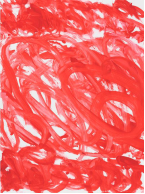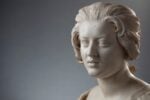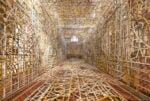Intuition

Mostra collettiva
Comunicato stampa
To coincide with the 2017 Venice Art Biennale, Axel Vervoordt and Daniela Ferretti will present Intuition at the Palazzo Fortuny. This exhibition will explore how intuition has, in some form, shaped art across geographies, cultures and generations. It will bring together historic, modern and contemporary works related to the concept of intuition, dreams, telepathy, paranormal fantasy, meditation, creative power, hypnosis and inspiration.
Organised by the Axel & May Vervoordt Foundation and the Fondazione Musei Civici di Venezia, Intuition will be the sixth, and final, in a highly acclaimed series of exhibitions at the Palazzo Fortuny, which include Artempo (2007), In-finitum (2009), TRA (2011), Tàpies. Lo Sguardo dell’artista (2013) and most recently, Proportio (2015).
Intuition is the ability to acquire knowledge without proof, evidence, or conscious reasoning: a feeling that guides a person to act in a certain way without fully understanding why.
Some of the earliest works on display in the exhibition will reveal the role of intuition in encouraging artists to connect the two worlds, first attempts by men to create an immediate link between the sky and the earth: from the erection of totems to shamanism and mystical ecstasy; and from religious iconography describing illuminations (Annunciation, Visitation, Pentecost…), to classical works capturing the divine revelation of dreams.
Modern works by Vassily Kandinsky, Paul Klee, Hilma af Klint and more will highlight the intuitive experience and feeling that drives the creative process, and led to the rise of abstract art. The importance of the spatial and temporal research undertaken by the Gutai, Cobra, Zero, Spazialismo and Fluxus groups will be illustrated with works by Kazuo Shiraga, Pierre Alechinsky, Günther Uecker, Lucio Fontana, Mario Deluigi and Joseph Beuys.
The Surrealists interest in the unconscious will also be an important focus of the exhibition. Their fascination with dreams, automatic writing and drawing, collective creations and the state of alteration of the ego will be represented with the ‘dessins communiqués’ and ‘cadavres exquis’ of André Breton, André Masson, Paul Eluard, Remedios Varo, Victor Brauner amongst others, along with experiments in camera-less photography by Raoul Ubac and Man Ray, and works on paper by Henry Michaux, Oscar Dominguez and Joan Miró.
The Surrealist’s legacy will be reflected in a number of works by contemporary artists such as Robert Morris, William Anastasi, Isa Genzken, Renato Leotta and Susan Morris who, since the 1960s, have revived, developed and modernised automatism, leading to new formal and technical results. Other contemporary works by artists including Marina Abramović, Chung Chang-Sup, Ann Veronica Janssens and Anish Kapoor, are inspired by striking subjective experiences or states of mind, and the artists’ concern and preoccupation with the viewer.
During the opening days visitors will be invited to explore and experience the paranormal fantasy of artists through four performances related to dreams, telepathy, and hypnosis – of the mind and body –by young artists Marcos Lutyens, Yasmine Hugonnet, Angel Vergara and Matteo Nasini.
Intuition aims to provoke questions about the origins of creation, and is intended to be viewed as a ‘work in progress’, with leading contemporary artists creating a dialogue with the historic works and the unique character of the Palazzo Fortuny. Kimsooja, Alberto Garutti, Kurt Ralske, Maurizio Donzelli, Berlinde De Bruyckere, Gilles Delmas and Nicola Martini will all create site-specific installations as part of the exhibition - a direct, and intuitive, response to the spaces within.
Daniela Ferretti, Director of the Palazzo Fortuny, said: ‘It has been twelve years since I met Axel Vervoordt; it was a day in August and the beginning of our intense collaboration. Together, we started an exploration of the arts and, more generally, of the concepts of thought and reflection. It was intended as a continuous questioning of the universal themes that each historical period interprets through new prisms. We have dived into the same projects, often following different paths and approaches, but, in the end, always converging in a shared vision. To me, INTUITION is therefore the synthesis of a long journey, the end of a research cycle, which opens new perspectives.’
Axel Vervoordt, Chairman of the Axel & May Vervoordt Foundation, said ‘Together with Director Daniela Ferretti, we have made a series of remarkable exhibitions in Palazzo Fortuny exploring the transversal links between philosophy, science, music, history, creative heritage and art. Much like Artempo, Infinitum, Tra and Proportio, Intuition is another concept that has fascinated me all my life, and which we wanted to study more scientifically. Intuition is a sense that comes out of total freedom, being one with cosmic energy. It is the Beginning and the End. This is a poignant theme for our final exhibition at the Palazzo Fortuny.’
At the start of December Axel Vervoordt Company will open Kanaal, a former C19th distillery and malting complex on the banks of the Albert Canal, just outside of Antwerp. This remarkable ‘island’ has been conceived and designed by Axel Vervoordt as a “City in the Country”, in collaboration with the Belgian architects Stéphane Beel, Coussée & Goris and Bogdan & Van Broeck, and the French landscape designer Michel Devisgne. It brings together residential, commercial and cultural spaces, and the natural world, within a shared community. At the heart of Kanaal will sit a complex of exhibition spaces, housing the permanent collection of the Axel & May Vervoordt Foundation and the Axel Vervoordt Gallery, as well as a revolving programme of temporary exhibitions.
AXEL VERVOORDT
Axel Vervoordt (Antwerp, b. 1947), collector, curator, tastemaker and dealer, is known for his inimitable taste which spans centuries, continents and socio-economic strata. His knowledge of and deep fascination with the history of the arts – in particular the ZERO and Gutai movements - has led him to advise and inspire collectors from around the world. He is the founder of the eponymous company which, over the past four decades, has created a nonpareil approach to living with art. The arts and antiques chapter, the core business of the Axel Vervoordt Company, is complemented with an art gallery, interior and conservation consulting services, as well as a home collection. These four business activities are now overseen by Axel’s eldest son Boris, while Axel and his wife May continue to inspire and mentor the company, artists, broader audiences and friends alike with the non-profit activities of the Axel & May Vervoordt Foundation, and by fostering musical and artistic patronage through their event series, Inspiratum. www.axel-vervoordt.com
DANIELA FERRETTI
Daniela Ferretti is the Director of the Palazzo Fortuny, part of the Fondazione Musei Civici di Venezia. She graduated in architecture, and specialises in exhibition design. In 1980, Ferretti was hired by the City of Venice to manage the Cultural Delegate’s Exhibition Office and in 1999 she became Coordinator of the Exhibition Department and Exhibition Planning for the Foundation of the Venetian Civic Museums. From 1977 to date, she has planned more than 200 exhibitions for public and private institutions, in Venice and elsewhere, collaborating with leading Italian and foreign critics and art historians. Her professional experience goes further than solely exhibition design, and includes the overall organisation of major retrospectives. She was co-commissioner of the exhibitions Artempo (2007), In-finitum (2009), TRA (2011), Tàpies. Lo Sguardo dell’artista (2013) and Proportio (2015) at Palazzo Fortuny, and Fortuny El mago de Venecia in Barcelona. Since June 2007 she has been the Director of the Fortuny Museum. In the summer 2008 she became the first foreign member of the board of the Fondation Maeght, Saint-Paul-de-Vence, France.
THE PALAZZO FORTUNY MUSEUM
Once owned by the Pesaro family, this large Gothic palazzo in Campo San Beneto was transformed by Mariano Fortuny into his own atelier of photography, stage-design, textile-design and painting. The building retains the rooms and structures as they were created by Fortuny, as well as providing a home to his tapestries and collections. The working environment of Mariano Fortuny is reflected through a selection of precious wall-hangings, paintings, and the famous lamps he designed for stage lighting – all objects that testify to his inspiration and still give count of Fortuny’s eclectic work and his formidable presence on the intellectual and artistic scene at the turn of the nineteenth century.
The Fortuny Museum was donated to the city in 1956 by Henriette, Mariano's widow. The collections within the museum comprise an extensive number of pieces and materials which reflect the various fields investigated in the artist’s work. These are organised under specific headings: painting, light, photography, textiles and grand garments. www.fortuny.visitmuve.it



